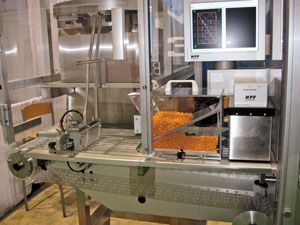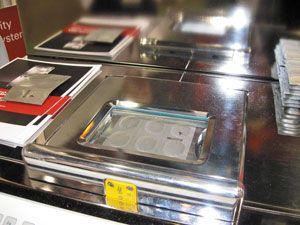Blister Packaging Moves Forward
Advances in materials and equipment for pharmaceutical blister packaging protect quality and enhance shelf life.
Blister packaging, a common format for solid dosage forms, continues to evolve. Equipment advances combine flexibility, servo controls, compact size, and integration with upstream and downstream equipment. Material and quality-control innovations focus on protecting product quality and maximizing shelf life. Pouch options wait in the wings to replace cartons.
A new entry in the North American market, the MHI Eagle blister packaging machine from Maruho Hatsujyo Innovations (MHI), is an American version of its parent company’s best-selling machine. Established in 2014, MHI provides US-based installation, maintenance, spare parts, and 24/7 technical support. Parent company, Kyoto-based Maruho Hatsujyo Kogyo, ranks as the second largest pharmaceutical packaging machinery company in Japan and has installed nearly 400 blister packaging machines there. “There is no child-resistant (CR) requirement in Japan, so we had to design sealing for CR lidding (push, peel/push, and peelable),” reports Gregory Zaic, president and CEO of MHI.
Figure 1. A removable feeder module on the MHI Eagle blister packaging machine enables off-line cleaning and cuts downtime. Figures are courtesy of the author.

The MHI Eagle blister packaging machine (see Figure 1) operates at speeds up to 100 blisters per minute at a maximum index length of 90 mm and maximum index width of 130 mm. Designed for lower volume runs, the compact, servo-driven machine with inline inspection and multi-zone preheating is especially well-suited to copackers and lines with frequent changeovers (1). With hand screws to expedite tooling changes, changeover takes less than 10 minutes and requires no tools. Other quick changeover features include recipe-driven format change and a feeder station on wheels that plugs into the main unit. “We sell two feeder stations for the price of one-and-a-half so feeders can be swapped at changeover,” says Zaic. Swapping units moves feeder cleaning offline and minimizes downtime for cleaning. The Eagle blister packager accepts feeders from other manufacturers and is easily integrated with a printer or cartoner.
A fully integrated, modular line from Körber Medipak’s Mediseal thermoforms, doses, seals, punches (perforates and embosses), diecuts, and feeds inserts and cartons. Direct product transfer eliminates fault-prone intermediate stacking units and minimizes change parts. Cameras confirm an insert is placed on every other blister before pairs of blister cards are stacked for cartoning. A display at Pharma EXPO (Nov. 6–9, 2016) showcased an integrated line on its way to a factory acceptance test. The one-lane CP400 blister packager integrated with a P1600 cartoner featured hot-melt carton sealing but also could accommodate tuck carton closure. Other potential variations include a P3200 cartoner with dual stacking devices, integration of a printer from HAPA for online printing of lidstock, various dosing systems (brush box, roller dosing, automatic spiral conveyor, or dedicated feeder) and choice of roller or platen sealing. Maximum speed of the servo-driven line is 400 blisters per minute (2). A sophisticated human/machine interface (HMI) groups functions for ease of use and helps reduce changeover time to less than 30 minutes. “All the information is in the HMI, which provides detailed instructions by system for format changes,” Kai Trepte, area service manager at Mediseal, explains.
Blipack, a company based in Argentina, also supplies integrated blister forming and cartoning lines. The centerpiece, the Blistera 200-240 blister packaging machine, combines heavy-duty construction with user-friendly operation and quick and easy changeover and maintenance. The system can be electromechanical or driven by a programmable logic controller and is compatible with thermoforming or cold-forming and a wide range of accessories including printers and semiautomatic, automatic, dedicated, and universal feeders (3). Blipack’s integrated Estuchadora ACM 150 intermittent-motion cartoner loads cartons horizontally. Carton sizes range from approximately 0.6 x 0.5 x 2.0 in. to 3.5 x 2.8 x 7.9 in. (4).
Another turnkey blister packaging line integrates the TF1e thermoformer and the TC1 cartoner from Pharmaworks. The unified system results in a compact footprint, operates from a single control system, and produces up to 100 blisters/80 cartons per minute. A robotic pick-and-place module transfers blisters from die punch to cartoner flights and eliminates the need for change parts. The number of blisters transferred to the cartoner flights is controlled from the operator interface (5).
Robotics also play an important role in the Integra 520 V integrated blister packaging line from Marchesini Group. The servo-driven system fits in 10 m of floor space and features a balcony design for the thermoforming and cartoning sections. Capable of producing 520 blisters and up to 500 cartons per minute, the Integra 520 V line succeeds the Integra 320 model and incorporates an innovative pusher, a drum-type carton-opening system to manage higher speeds, and a new leaflet pickup and insertion system. Separating product loading from electrical and mechanical zones ensures quick and straightforward cleaning and changeover. An enclosed oil bath system protects mechanicals from wear and tear and extends service life. Maximum forming depth measures 9 mm, although a 12-mm option is available. Carton sizes range from 35 x 16 x 75 mm to 90 x 90 x 150 mm (6).
Uhlmann Packaging Systems, which has offered integrated blister packaging lines for some time, offers three models: the single-lane BEC 300 model for up to 300 blisters/150–300 cartons per minute; the dual-lane BEC 500, rated at 500 blisters/300–500 cartons per minute; and the three-lane BEC 700, capable of outputting 700 blisters/300–500 cartons per minute. Upgraded in 2015, the BEC 300 model features the latest control and drive technology, tool-free format changeover, and smooth surfaces for faster line clearance (7).
Existing BEC 300 systems can be retrofitted to shorten the forming cycle, simplify cleaning, and minimize abrasion marks on forming materials. Uhlmann’s Rebuild Packaging Systems Center performs electrical and mechanical retrofits using genuine Uhlmann parts to extend equipment lifespan and meet the latest GMP requirements and legal regulations. Upgraded equipment comes with detailed rebuild documentation, validation services, and one-year warranty. Rebuilding typically saves 30–70% compared to the cost of a new machine (8).
Carton alternatives
Cartons are the traditional secondary package for blisters, but CR pouches provide a lightweight, flexible packaging option. To simplify adoption of a CR pouch, the Child-Guard CR track and slider from Presto Products has a Drug Master File listing. In use, the caregiver moves the Child-Guard slider over a notch, pushes down on a tab and pulls back the slider to open the pouch (9). CR pouches from Impak meet ASTM (American Society for Testing and Materials) D3475 CR standards. Sliding tab or press-to-close CR designs require two-handed dexterity to open, making access difficult for toddlers but not for seniors (10).
Quality control
Quality control systems confirm blister packaging equipment is working properly. Systems, such as the camera-based IBIS inline blister inspection system from Pharmaworks (11), check product and print on sealed blisters. Installed inline or offline, the vision system identifies flaws such as mis-shaped, damaged, missing, or rogue product, as well as incorrect color and foreign objects.
Figure 2. In a Pharma EXPO demonstration, the standalone AMI 120 leak detector from Pfeiffer Vacuum checked cold-formed foil blisters.

Seal integrity is checked on units such as the AMI 120 leak detector from Pfeiffer Vacuum (see Figure 2). The leak detector requires no tracer gas to nondestructively detect holes as small as five microns, a sensitivity up to 1000 times better than the traditional destructive blue dye dunk test. “Using helium as a tracer gas boosts sensitivity even more,” says Dennis Seibert, head of business development, Leak Detection, at Pfeiffer Vacuum. Time spans for the offline test range from 10–60 seconds. Calibrated orifices quantify the leak rate and provide an alert if seal quality is deteriorating. Compatible with thermoformed or cold-formed blisters, testing a different blister only involves a simple fixture change.
The VeriPac UBV leak detection system from PTI Packaging Technologies and Inspection combines vacuum with volumetric imaging to detect leaks in multi-cavity blister packs. The nondestructive test involves three steps: input the number of blister cavities; place the blister pack on the inspection plate; press start. In seconds, the display shows pass or fail, the volumetric measurement reading, and the location of any defective cavity. The technology provides rapid detection of defects as small as 10 microns in a test cycle that lasts less than 15 seconds (12).
Innovative materials
Activ-Blister material from CSP Technologies heat-stakes absorbent material to the interior of blister cavities. Silica gel and molecular sieve technology absorb tailored amounts of water vapor, oxygen, or a combination of the two to control the internal atmosphere of each cavity and protect product shelf life. The active feature can be adopted without changing the footprint of the packaging line (13).
Another option for sensitive products, Pentapharm LiquiGuard films from Klöckner Pentaplast offer protection from package leaching and moisture gain or loss. The crystal-clear, autoclavable laminate accommodates hot-fill liquids, gummies, and other emerging dosage forms. Features include a customizable moisture barrier, excellent deep-draw properties for complex blister geometries, high heat stability (the glass transition temperature of the contact layer is 120 ºC), high slip for quick release and increased productivity, and low leachability and extractability, with excellent odor and flavor retention. Applications include chewables, formulations sensitive to flavor or odor loss, nutraceuticals, pharmaceuticals, unit-dose liquids, and veterinary products (14).
References
- Maruho Hatsujyo Innovations, “At Pharma Expo, Maruho Hatsujyo Innovations to Introduce Blister Machine Specifically for U.S. Market,” Press Release, Aug. 25, 2016.
- Mediseal, “Flexibility All Along the Line,” Brochure, undated.
- Blipack, “Blister Packaging Machine 200-240,” www.blipack.com.ar/eng/factory/200.htm, accessed Nov. 23, 2016.
- Blipack, “Cartoning Machine ACM 150,” www.blipack.com.ar/eng/factory/acm150.htm, accessed Nov. 23, 2016.
- Pharmaworks, “TF1e/TC1 Line (New!), the All-in-One Solution,” www.pharmaworks.com/index.php?id=210, accessed Nov. 23, 2016.
- Marchesini Group, “All4Pack Paris: Marchesini Group Showcases the Amazing Integra 520 V Line and Two New Stand-Alone Machines,” Press Release, Sept. 22, 2016.
- Uhlmann Packaging Systems, “Blister and Cartoner Module in One Productive Unit,” www.uhlmann.de/products/blister-lines.html, accessed Nov. 23, 2016.
- Uhlmann Packaging Systems, “Uhlmann USA to Ramp Up Machine Rebuilding Services at New Jersey Facility,” Press Release, Aug. 24, 2015.
- Presto Products, “Slide-Rite Child-Guard Track & Slider,” http://fresh-lock.com/product-list/slide-rite-child-guard-slider-zippers/, accessed Nov. 27, 2016.
- Impak, “Impak Offers the Largest Selection of Child Resistant Pouches, Plus the Option for Labeling and Custom Print,” www.impakcorporation.com/flexible_packaging/child-resistant-pouch, accessed Nov. 27, 2016.
- Pharmaworks, “IBIS Inline Inspection,” www.pharmaworks.com/index.php?id=271, accessed Nov. 23, 2016.
- PTI Packaging Technologies and Inspection, “Introducing New Non-Destructive Technology for Blister Package Testing at PACK EXPO International,” Press Release, Nov. 2, 2016.
- CSP Technologies, “CSP Technologies, Inc. Introduces Activ-Blister Solutions for Customizable Product Protection at INTERPHEX NYC,” Press Release, April 28, 2016.
- Klöckner Pentaplast, “Pentapharm LiquiGuard Films from Klöckner Pentaplast,” Press Release, Oct. 26, 2016.
Article DetailsPharmaceutical Technology
Vol. 41, No. 1
Pages: 64–67
Citation:
When referring to this article, please cite it as H. Forcinio, "Blister Packaging Moves Forward," Pharmaceutical Technology 41 (1) 2017.
About the Author
Hallie Forcinio is Pharmaceutical Technology’s Packaging Forum editor, 4708 Morningside Drive, Cleveland, OH 44109, Tel. 216.351.5824, Fax 216.351.5684, editorhal@cs.com.

Drug Solutions Podcast: A Closer Look at mRNA in Oncology and Vaccines
April 30th 2024In this episode fo the Drug Solutions Podcast, etherna’s vice-president of Technology and Innovation, Stefaan De Koker, discusses the merits and challenges of using mRNA as the foundation for therapeutics in oncology as well as for vaccines.